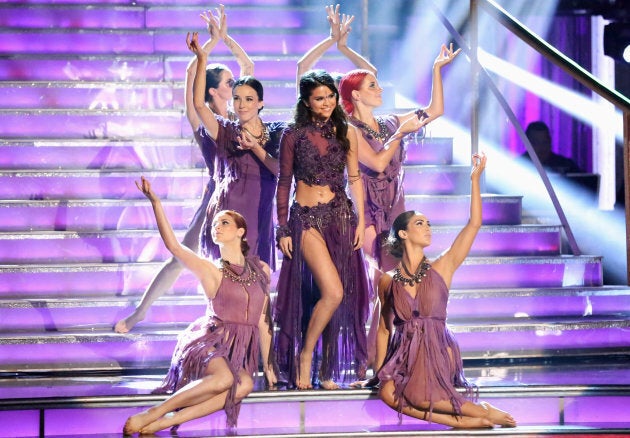Cultural appropriation.
The words themselves seem to make us uncomfortable and squeamish in our seats. It's a highly controversial topic that we hear about in the headlines more and more. According to Nico Lang of the Los Angeles Times:
"Cultural appropriation highlights the power imbalance that remains between those in power and those who've been historically marginalized. As such, a member of a dominant group can assume the traditional dress of a minority group for a Halloween party or a musical performance. Yet, they remain blissfully unaware of the roots of such dress and the challenges those who originated it have faced in Western society."
So, does this mean that if you're not Indian you can't wear a bindi or sari? Well, no -- but the line is thin and definitely not straight, so we must walk carefully.
Definitions. What does this really mean?
The definition of the term "cultural appropriation" is "the adoption or use of elements of one culture by members of a different culture." Then there is "cultural appreciation." While I don't have a dictionary definition for this, I would characterize it as having a genuine or authentic interest in a culture; in learning about the history (the good and bad), the people and its perspectives and building relationships with members of that culture on the basis of that understanding.
If you have an appreciation for a culture then it actually makes it much more difficult to appropriate it, because you are more likely able to recognize whether your actions will be taken as disrespectful or embraced by the people of that culture.
Fast-forward to Beyonce adorned in henna, and suddenly my culture is cooler than ever. Or is it?
R-E-S-P-E-C-T. Find out what it means to me
Respect is one of the most important yet most violated values when it comes to cultural exchanges. When we moved from England in the mid 1980s, we spent our first few years living in the small town of Brantford, Ont. We were one of very few non-white families, and to say that there was some racism is putting it mildly.
My mom would wear a sari and bindi often for celebrations and religious ceremonies. She taught me that I should always wear my bindi for religious functions and the significance of it. But I heard those words "P*ki dot" more than I'd like to remember from snarky little kids, teens and parents alike -- and they stung. Fast-forward to Gwen Stefani and Selena Gomez rocking bindis and bras on-stage, to Beyonce adorned in henna, and suddenly my culture is cooler than ever. Or is it?

Bindis and henna have historic religious and cultural significance. To be honest, part of me does feel irked that growing up my culture was mocked and degraded, and then some pop stars came along and decided they liked parts of it -- well, the parts they liked -- and suddenly it was cool. And while I don't blame all white women on the face of this earth for those ignorant few in Brantford, I do think a celebrity and the average individual alike who wishes to borrow from my culture has the duty to show it some respect. You have to be mindful of the presentation and usage of the cultural element you borrow.
Context is critical
It's important to ask yourself if the context in which you are adopting an aspect of a culture is appropriate. For example, wearing a bindi to a pop-rock concert is out of context. Why? Ask yourself a few questions. Does the concert have anything to do with Indian culture? Does Selena Gomez wearing a bindi in her "Come and Get It" performance have any cultural connection? But she or anyone else could easily wear that bindi as a guest to an Indian wedding, Diwali dinner and many other functions, and it would most likely be embraced as a celebration of the culture.
Likewise, feather headdresses are all the rage at music festivals. But these are tribal symbols of spirituality and status that don't have anything to do with these festivals. It's not that it's off-limits to wear accessories from aboriginal cultures, but context is critical. Does the context of Coachella have anything to do with the culture you're borrowing from? If not, then maybe you shouldn't be wearing that particular accessory. For this reason, some music festival organizers have prohibited feather headdresses.
As the Guardian pointed out, it's anyone's right to dress like an idiot at a festival, but someone else's sacred object shouldn't be a casual accessory.

What about your friends? Relationships matter.
Another way to gauge if you're getting it right is looking at your relationships. Do you have a relationship to the people of that culture? Part of understanding a culture is knowing the different perspectives of the people within it. It's not remote observations, but real interactions, dialogues and friendships. And no, I don't mean that one "token brown friend." No culture is homogeneous in its ideas, and part of understanding a culture is knowing the different perspectives its members have. The reason Amandla Steinberg's question "What would America be like if it loved black people as much as it loves black culture?" has been cited repeatedly in the discussion on cultural appropriation is because it is so relevant to the conversation.
I have many non-Indian friends who love the music, food and vibrant colours of my culture. But I try to make a deliberate effort to show them the not-so pleasant issues in it as well. We have gender inequality, shadism, religious wars, elitist class systemsand more. And while none of it is pretty to look at, it's important to see the whole picture. If you have a relationship with people of a culture you will be far less likely to appropriate it because you will understand the rules of engagement.
Cultural appreciation and exchanges from another culture can be a force for good.
They enrich the available vocabulary for designers, artists and image-makers. Fashion, in particular, thrives on forms of cultural appreciation -- but it has to be done right. There has to be regard and respect of the culture from which you are drawing. And even though its 50 shades of confusing grey, with some gentle care, who knows. One day we may even get it right.
Meera Estrada is a Fashion & Culture Expert. Follow her on Instagram @meera_fusia and Twitter @MeeraEstrada.
Follow HuffPost Canada Blogs on Facebook
Also on HuffPost:
